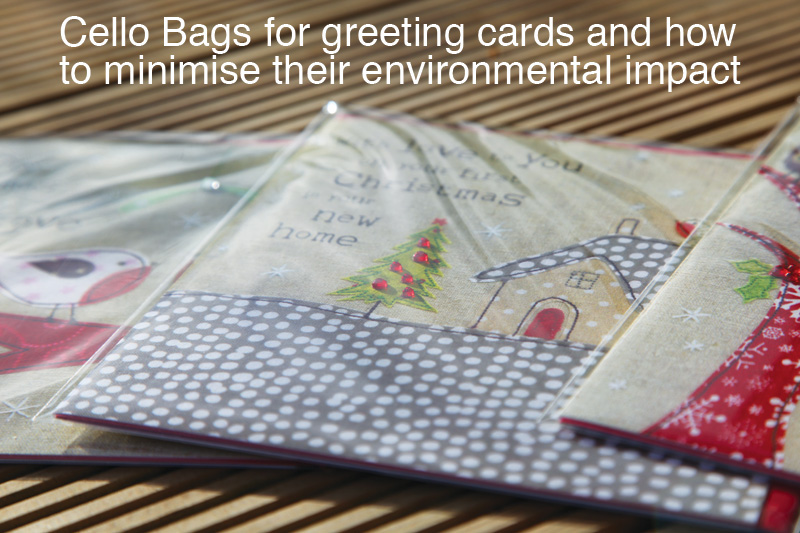Cellophane bags are commonly used on greeting cards in the UK and around the world. Whilst there was a time when lots of retailers would stock cards without wrapping, these days many are now demanding it from their suppliers. Cello bags protect greeting cards from the many fingers that touch them on a daily basis in retailers' card racks. Purchased cards are opened in good condition and consumers feel that they get value for their purchase in much the same way that many shoppers now like to have their fruit and vegetables wrapped and protected at supermarkets. Yet we all know that plastic can be damaging to the environment and takes a long time to degrade.
Recently I spoke to Richard Smith from Wrapid Manufacturing at a GCA Council Meeting to see if there is anything we can do as card publishers to reduce our impact on the environment, specifically in regard to cello bags for greeting cards. Here's what I learned:
There are currently three main options of cello bags for greeting cards:
PLA (aka Corn Starch film)
PLA (poyl-lactic acid) is a bio plastic obtained from starch or sugar taken from plants such as corn, sugar beet, sugar cane, potatoes and many others. One of the benefits of this option is that plant photosynthesis removes CO2 (carbon-dioxide) from the atmosphere to transform it into sugar or starch which is then processed (through fermantation) into PLA. This bio plastic is then turned into compostable packaging material.
PLA is 100% compostible and will fully degrade into CO2, water and biomass which can be used as fertiliser in agriculture. This works well if consumers know to dispose of these compostable cello bags with their food waste. Composting only works if the compost heap is regularly turned. If not, the bag just sits in a pile and will take much longer to degrade. In fact testing has proven that bio-plastic films do not biodegrade in landfill conditions due to low moisture content. Composting is also not easily available to everyone wanting to compost their corn starch cellophane bags. So what else can we do with them?
Poly-lactic acid film is 100% combustable and can be incenerated and transformed into clean energy. The CO2 previously absorped by the plants is released back into the atmosphere to be absorped by plants again and converted into starch and sugar once more. PLA can also be mechanically recycled after grinding, recrystallisation and re-granulation. It can also be chemically recycled back into lactic acid, purified and polymerised into high quality 1st grade PLA resin. Of course some of these processes require a lot of energy in order to recycle the material effectively. Also, because PLA requires food product to be used to make it, is it morally acceptable to be using food for packaging instead of feeding people? Will we have enough to do both?
I know of several publishers who have tried to use corn starch cello bags for their greeting cards over the last few years. A common problem with PLA is that it can degrade too quickly when exposed to moisture. Some retailers report that the bags fall apart before the cards in them have been sold. PLA film also creases and crinkles very easily. The cello bags can look poorly made which can also have a negative effect on card sales for retailers. PLA cello bags are also more expensive than regular cello bags for cards at roughly four times the price.
Modified Polypropylene
This option takes regular polypropylene cello film and adds a proprietary formulation to special processing conditions that accelerate the degradation of the packaging when discarded. These conditions include the availability of oxygen, natural light, pressure and slightly elevated temperatures (over 30-40 degrees C, typical in landfill sites). It also degrades in the open air if the plastic is properly disgarded as litter. Under these conditions the cello bags will degrade within 8-18 months by a process of abiotic oxidation. In oxygen rich atmospheres, micro organisms attack under enzymatic action and convert the final mineralisation of the material into water, CO2, methane and biomass.
This option for greeting card cello bags is cheaper than PLA and it still biodegrades, but it isn't compostable. It's designed to suit landfill and degrades faster than conventional polypropolene cellophane. It can be mechanically and chemically reused after grinding, re-crystallisation and re-granulation. It can also be incenerated, but this sin't the most environmentally responsible method.
As you can imagine the relatvely short life span and danger of degrading on the shelves can affect the perceived value of the cards that are wrapped in modified polypropylene in the same ways the corn starch bags often do. Pricing wise this option is 50% cheaper than PLA.
Conventional Polypropylene
This is the most commonly used packaging medium for wrapping greeting cards as well as most other forms of packaging worldwide. It's also the least green option when considering biodegradation or compostability. Having said that, it is 100% recyclable through council refuse collection facilities linked to managed recycling programmes. What's important is that consumers know they can add the cellobag to their plastic recycling. If they do, then our greeting card cello-bags can be mechanically or chemically recycled into low grade plastic products like carrier bags and coloured plastic bottles. If they don't, polypropolene bags can take over 400 years to degrade in landfill. Inceneration is also not a very environmentally responsible method of disposal.
I think there are two main reasons why polyproylene is used by publishers for their cello bags: It's the cheapest option available commercially and polypropylene cello bags add to the perceived retail value of the product. Because polypropylene doesn't crinkle and crack as easily as other options do these cello bags make cards look and feel more expensive. Combine these two main factors with others like the fact that they don't fall apart on retailers' shelves and it's easy to see why everyone uses them.
New Green materials?
Research and development work is currently ongoing with the prospect of some new technology being released into the market which will be totally different to the esisting substrates. It is expected that these will be coming through for general supply in about 12 months time. This could be exciting news, but we shall have to wait and see whether these options are viable commercially and will work operationally with existing production processes.
To be green costs money
When we first met with Richard, I was hoping that using the combined power of our industry we could encourage the development of more environmentally friendly cellobags for the greeting card marketplace. The truth is that greeting cards are a tiny blip in the world of packaging. To put it in perspective, the manufacturers that supply our suppliers with the film they use to make our our greeting card cello bags supply 30 times more to other packaging markets.
Who will pay for the premium commanded for technologically advanced films? In theory, if everyone in the supply chains contributed by paying a little more (and consumers added to this when purchasing) then we can all contribute to making a difference to the planet for future generations. The realities of making this happen are challenging. A key driver will be consumers demanding more advanced, eco friendly film for food packaging which uses the majority of polypropylene film. The supermarkets will have a big role to play in this. Already a lot of attention is focussed on reducing the use of plastic carrier bags in the UK, if we can do this with other packaging too the drive will be turned from a "should" into a "must" for everyone involved.
What can card publishers and retailers do?
Recycling virgin polypropylene (standard films) through council recycling programmes is the most responsible and affordable approach for our environment. We need to encourage our greeting card cello-bags to be recycled. Labelling and good comminication with retailers and consumers is key for this.
Another thing we can do to reduce the impact on the environment is to down guage the film thickness and limit the amount of material. Certainly we should discourage the use of greeting card cello bags that are greater than 40 microns. There really is no need to go thicker than this. If we could all shift our bags to 30 microns we would have a 25% reduction in the material used. This would be a massive improvement although it will be challenging to achieve, as many publishers use 40 micron bags because they feel nicer and more expensive than 30 micron. It could be damaging to business if your products were thought of as becoming less commercially appealing because of a change in the cello thickness.
Finally we can reduce the use of plastic in our everyday lives. The biggest way of doing this is to look at how much polypropylene is in your shopping basket at the supermarket. See if you can make alternative choices like buying fruit and veg loose instead of prepackaged for example. Let your supermarket know that this is important to you as a consumer. If the supermarkets can push the polypropylene manufacturers to come up with more enronmentally friendly solutions this will have a knock on effect for our industry too.
Read about Germany's first waste free supermarket by clicking here
Click here to read more card industry news
Find out more about the Greeting Card Association
Visit Wrapid's website for greeting card cello bags
If you're interested in the environment and waste then you might also find this informative














